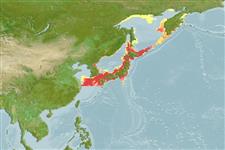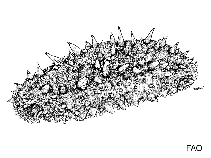Apostichopus japonicus (Selenka, 1867)
Japanese sea cucumber| Native range | All suitable habitat | Point map | Year 2050 |

|
| This map was computer-generated and has not yet been reviewed. |
| Apostichopus japonicus AquaMaps Data sources: GBIF OBIS |
Classification / Names Populärnamn | synonymer | CoL | ITIS | WoRMS
Holothuroidea | Synallactida | Stichopodidae
Environment: milieu / climate zone / djupintervall / distribution range Ekologi
; djupintervall 0 - 200 m (Ref. 635), usually 50 - 100 m (Ref. 635). Subtropical; ? - 30°C (Ref. 77134), preferred 16°C (Ref. 107945); 63°N - 31°N, 117°E - 165°E (Ref. 112755)
Distribution Länder | FAO områden | Ekosystem | Förekomster | Utplanteringar
Northwest Pacific: Japan (from Hokkaido to Kyushu), China, Korean Peninsula and Far Eastern Russia (Karaginskogo Island).
Length at first maturity / Size / Weight / Age
Könsmognad: Lm ?, range 20 - ? cm Max length : 30.0 cm TL hane/ej könsbestämd; (Ref. 101467)
Life cycle and mating behavior Könsmognad | Reproduktion | Lek | Eggs | Fecundity | Larvae
Main reference
referenser | Koordinator | Medarbetare
Kan-no, M. and A. Kijima 2003 Genetic differentiation among three color variants of Japanese sea cucumber Stichopus jamponicus. Fisheries Science 69:806-812. (Ref. 77132)
IUCN Red List Status
(Ref. 130435: Version 2025-1)
CITES status (Ref. 108899)
CMS (Ref. 116361)
Threat to humans
Human uses
Fiskeri: kommersiell; Vattenbruk: kommersiell
FAO - Vattenbruk: production, species profile; fiskeri: landings | FishSource | Sea Around Us
Verktyg
Ytterligare information
Max. ages / sizes
Length-weight rel.
Length-length rel.
Length-frequencies
Mass conversion
Abundans
Internet-källor
BHL | BOLD Systems | CISTI | DiscoverLife | FAO(Vattenbruk: species profile; fiskeri: ; publication : search) | Fishipedia | GenBank (genome, nucleotide) | GloBI | Gomexsi | Google Books | Google Scholar | Google | PubMed | Tree of Life | Wikipedia (Go, sök) | Zoological Record



